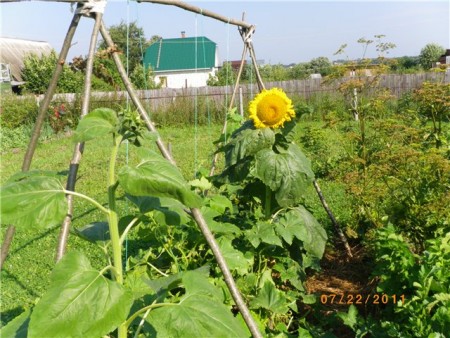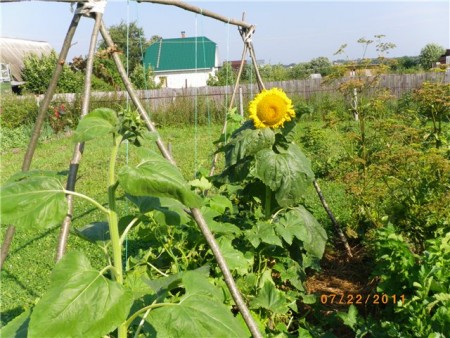Owners of small plots try to compact the plantings as much as possible in order to grow the largest possible harvest of vegetables, leafy greens, berries and fruits during the season. It has long been known that some crops growing nearby complement each other mutually beneficially.
A classic example is planting onions and carrots on one plantation or placing them next to each other. Phytoncides, secreted by the tops of carrots, repel the onion fly, and the pungent smell of the onion feather masks the greenery of the carrots, making it invisible to the main pest of the crop - the carrot fly.
Experienced summer residents recommend planting the following crops in the same garden bed or nearby:
1. Sunflower and cucumbers. Sunflowers present near cucumbers increase the yield of gherkins and the duration of their fruiting. The main thing is to plant tall sunflowers in such a way that they do not block the sunlight for the cucumbers.
2. Elderberry in the garden. The plant, planted in different parts of the garden, improves the microclimate of the plantings, repelling most pests (codling moths, leaf-eating caterpillars, mites, aphids).
3. Tansy and wormwood near apple trees. The spicy, bitter aroma spreading around the bushes of wormwood and tansy is not tolerated by apple moths, which is what experienced gardeners take advantage of when planting them under the crown of apple trees.
4. Marigolds and calendula in cabbage beds. Cabbage butterflies, whose larvae love to feast on fresh leaves of cruciferous crops, avoid planting if flowering marigolds and marigolds grow in the spaces between the vegetable rows or along the perimeter of the beds.
5. Tomatoes and basil. It turns out that spicy basil, growing near tomato bushes, can significantly improve the taste of ripening fruits.
6. Garlic and garden strawberries. Garlic phytoncides improve the microclimate of the entire area. The onion plant is of particular benefit to strawberry plantations, protecting the berry crop from diseases (gray rot) and pests (strawberry-raspberry weevil).
But it is undesirable to place a number of plants on the site in close proximity.Thus, apple and pear trees should be planted as far as possible from each other, since their roots developing during the growth process act mutually inhibiting.
Due to a common pest - the Colorado potato beetle - you should not plant nearby beds of potatoes, eggplants, peppers and tomatoes. In addition to the harmful beetle that flies from potato plantings to other nightshade plants, these crops also have a common disease - late blight. And if potato tops in August are no longer afraid of the activation of a fungal disease, then the rampant late blight in plantings of tomatoes, peppers and eggplants can destroy most of the crop.
Use our tips to simplify your work on the site during the hot summer season. Have a good harvest!



 CUCUMBERS NEVER GET SICK, I'VE BEEN USING ONLY THIS FOR 40 YEARS! I SHARE A SECRET WITH YOU, CUCUMBERS ARE LIKE THE PICTURE!
CUCUMBERS NEVER GET SICK, I'VE BEEN USING ONLY THIS FOR 40 YEARS! I SHARE A SECRET WITH YOU, CUCUMBERS ARE LIKE THE PICTURE! You can dig a bucket of potatoes from each bush. Do you think these are fairy tales? Watch the video
You can dig a bucket of potatoes from each bush. Do you think these are fairy tales? Watch the video
 How our fellow gardeners work in Korea. There is a lot to learn and just fun to watch.
How our fellow gardeners work in Korea. There is a lot to learn and just fun to watch. Eye trainer. The author claims that with daily viewing, vision is restored.They don't charge money for views.
Eye trainer. The author claims that with daily viewing, vision is restored.They don't charge money for views. A 3-ingredient cake recipe in 30 minutes is better than Napoleon. Simple and very tasty.
A 3-ingredient cake recipe in 30 minutes is better than Napoleon. Simple and very tasty. Therapeutic exercises for cervical osteochondrosis. A complete set of exercises.
Therapeutic exercises for cervical osteochondrosis. A complete set of exercises. Which indoor plants match your zodiac sign?
Which indoor plants match your zodiac sign? What about them? Excursion to German dachas.
What about them? Excursion to German dachas.